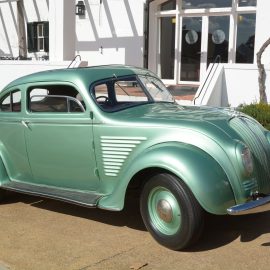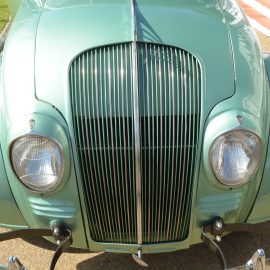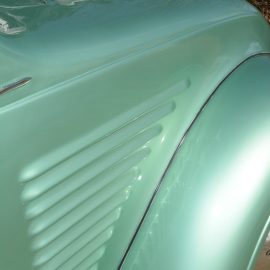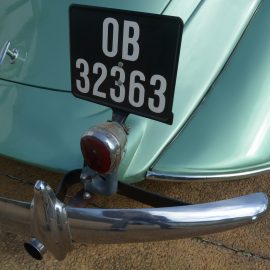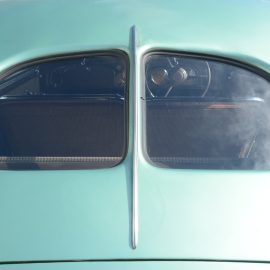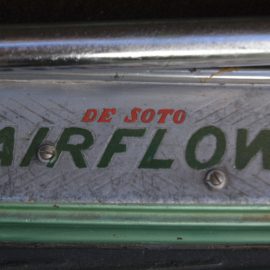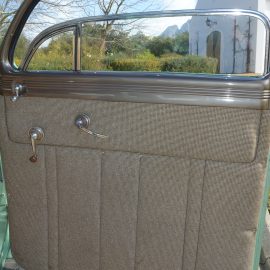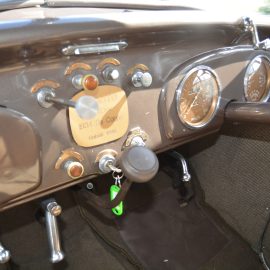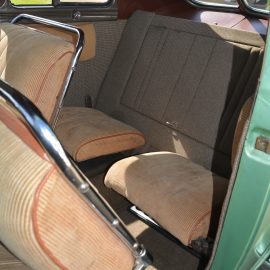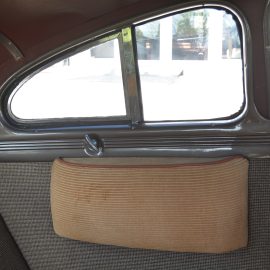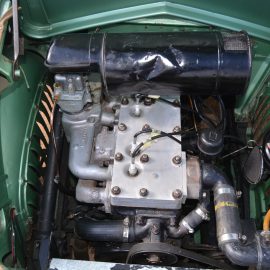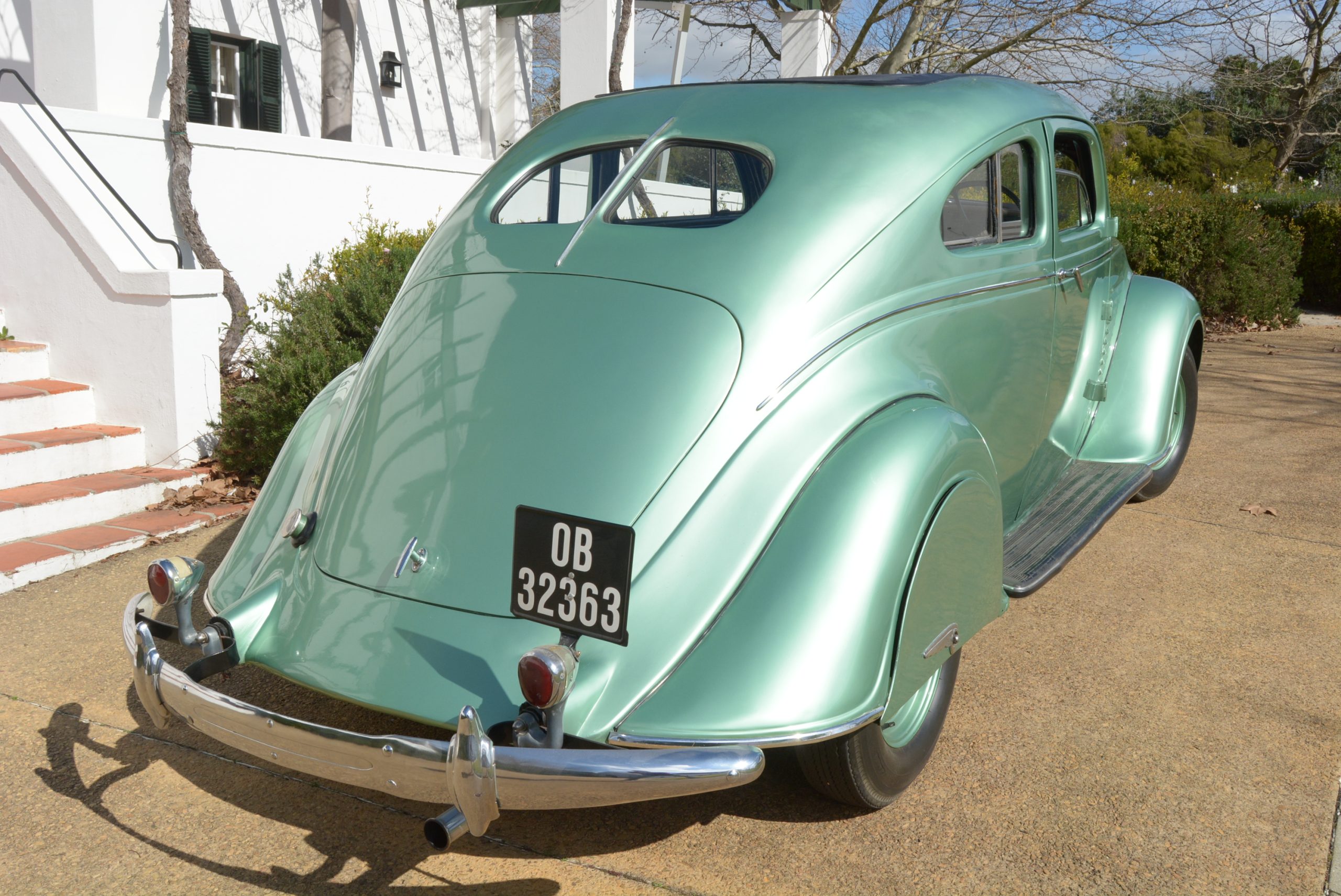
06 Aug Not So Dynamic Airflow
The DeSoto Airflow is a full-sized automobile built by DeSoto between 1934 and 1936. As part of the Chrysler Corporation, DeSoto received the then-revolutionary aerodynamic Airflow body style introduced on the larger and more expensive Chrysler Airflow model.
The Airflow’s design represented the first major attempt to smooth away the wind catching aspects found on most cars of the era. Headlights were moved from their traditional pods forward of the radiator, and housed in flush mountings on either side of the broad waterfall-styled grille, which lacked the traditional upright radiator throat and decorative cap ornament. In place of usual flat windscreen, the Airflow split the screen into two (opening) panes of glass, each angled to better redirect the air around them. Front and rear fenders received smoother, more form-fitting curves. In the rear, Airflows encased the rear wheels with fender skirts.
In addition to the benefits of its smoother exterior shape, which translated into a quieter passenger compartment, the DeSoto featured wider front seats and deeper back seats with more leg room. Because of the car’s monocoque construction, passengers rode within the frame of the car rather than on top, the seats being located away from the axles. The 1934-35 cars featured a round-faced dashboard, but more conventional square gauges were introduced in the last production year.
The Airflow boasted a stiffer body and better weight distribution through the engine placement over the front wheels, in contrast with the common practice of placing the centre of the engine just behind the front wheels. The 1934 DeSoto Airflow was offered as a two-door coupe, a two-door brougham, a four-door sedan and a four-door town sedan, which was the sedan with the rear quarter windows deleted. (It was sold in Great Britain as the Chrysler Croydon.) Power was supplied by a 241,5 ci (3 957 cc) flat-head six-cylinder engine rated at 100 hp (75 kW) at 3 400 r/min and 251 N.m of torque at 1 200. Top speed was 190 mph (145 km/h). A three-speed manual gearbox with freewheeling was fitted with a shaft drive to a semi-floating rear axle. Four-wheel hydraulic brakes were standard, and leaf-spring suspension was used all round. Fuel economy was given as 22 US mpg (10,7 litres/100 km).
Chrysler touted all of its Airflow bodies as ‘futuristic’, and the automotive press gave the cars positive reviews for their handling and acceleration. Interest in the Airflow was strong when it was introduced. Unfilled orders for it totalled 15 580 on April 30, 1934. But in the event, the American public found the cars to be too different in a time of economic uncertainty. While Chrysler-branded cars looked better with the Airflow bodies stretched over their longer wheelbases, the shorter 115,5-inch (2 934 mm) wheelbase of the DeSoto made the cars seem bulky. Walter P Chrysler, who had been a strong proponent of the Airflow project, was stunned by the lack of interest in the car, which he believed pointed the way for the future of American cars.
The Airflow certainly has some fascinating features. The framed front door glass drops down complete with the opening quarter light. And the stylised rear side glass is split so that the rear section can be opened. Two stout levers under the dashboard open up air vents just in front of the angled, split windscreen, each pane of which can also be opened. Who needs air-conditioning… The stylish headlights are topped with a neat DeSoto crest. The rear window is split with a thin ‘aerodynamic fin’. Upholstery is a rich, heavily-ribbed cloth and the rear seat backrest folds down to give access to the boot.
The car’s status was spoilt by ongoing rumours that the Airflow’s body was unsafe. Tests showed its all-steel unibody construction was safer than the usual body-on-chassis layout. One widely distributed advertising film shown in movie theatres featured an empty Airflow being pushed off a Pennsylvania cliff, falling over 110 feet (34 metres). Once righted, the car was driven off, battered, but recognizable! Still, the myth persisted that Airflows were unsafe.
While Chrysler continued to also offer more conventional models in 1934, DeSoto only offered the Airflow. Despite DeSoto selling more Airflows – production total for the year was 13 940 units – than Chrysler, the mother company sold more cars overall, with the majority being a redesign of the 1933 ‘regular’ Chrysler. Chrysler discontinued the DeSoto Airflow in 1936 and focused on the DeSoto Airstream so as to offer more traditional designs and achieve the higher sales volume that they brought the division.
The 1934 DeSoto Series SE Airflow is currently on display in Hall A.




